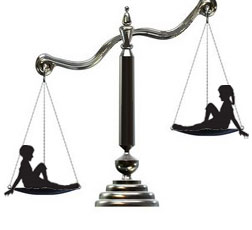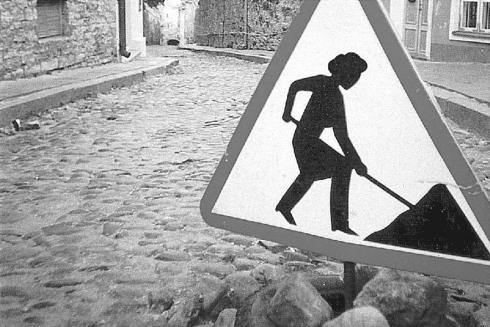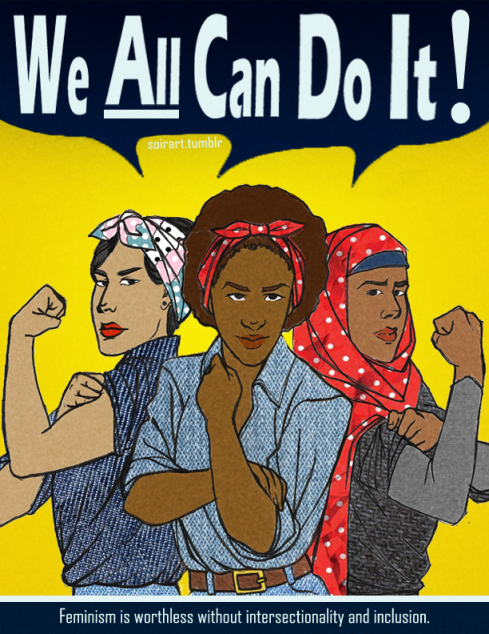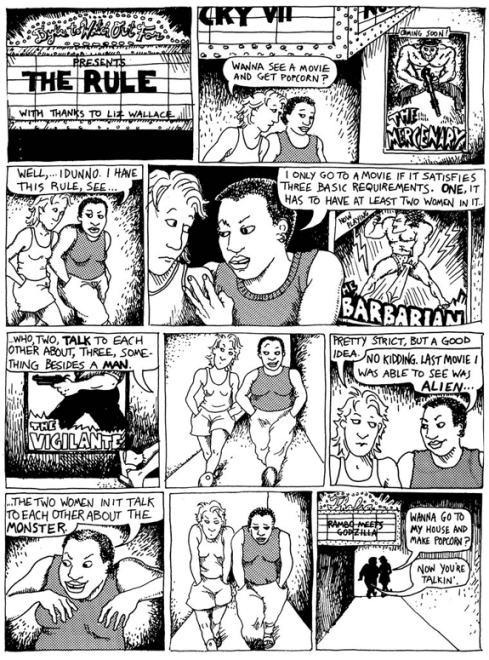What is the Bechdel Test?
The Bechdel Test was published in 1985, in the episode named “The Rule” from the comic “Dykes To Watch Out For“:
In summary, the test consists of three rules to analyze a movie:
1. There must be at least two women in it (some add the additional requisite of knowing their names).
2. They must talk to each other.
3. The conversation can’t be about a man.
Although originally it was meant as a humorous resource from a fictional character, eventually some people decided to put it into practice. The results were appalling: many, many, many Hollywood successes fail the test.
Ironically (or not so much), it also has been proven that movies which pass the Bechdel Test have a lower budget, make more money and and have a better overall return of investment than those which fail.
So what’s the Bechdel Test for?
In a general sense, we can say the test can be used to identify the gender gap in movies.
However, it is not an absolute measure of sexism, since a movie which passes the Bechdel Test can be even “more sexist” than one which doesn’t.
For example, the fact that two women talk to each other about something other than a man, does not prevent those same characters to be mainly revolving around men for the rest of the movie.
Or maybe they are all about shopping, or only living for their husbands and children, or any other stereotype about women’s gender role.

- Image from Periodismo y Social Media
However, it allows us to note that if the three rules are not followed, it’s practically impossible that there are female characters shown as independent from men in a movie.
This is not a minor detail, especially taking into account the number of movies which fail the test.
The test itself can only measure one particular dimension of sexism, but on the other hand it does so in a very eloquent way.
What we definitely can test is whether the movie does the bare minimum to acknowledges women have an independent existence from men.
Which is to say, if a certain plot shows female characters with the basic requisites to represent them as human beings.
The fact that most of the movies produced to the date do not pass the test, or barely passes it, shows that the idea of a woman being at best an accessory for a man is deeply ingrained in our society.
The good and the bad of the Bechdel Test
Disadvantages
As we already stated, the test has its limitations. So let’s get done with the lowlights.
For being so simple, it is useful to measure only one very specific possibility of sexism in movies.
Besides, passing the Bechdel Test does not guarantee that women will be correctly represented, nor does it exempt the movie from containing harmful stereotypes. On the other hand, it is also possible that a movie with a good female lead or abundant female characters still doesn’t pass the test.
For this reason, the test is not so useful for determining how sexist a specific movie is, but it is great for detecting general trends in the film industry.
Finally, this test cannot distinguish between different levels of sexism, since a movie either passes the test, or fails it. It is a yes-no test.
However, we should note that it’s the film industry itself who placed the bar so low regarding women representation that most movies fail a test as basic as the Bechdel Test.

Image from Eq Género
Advantages
The simplicity of the test is also an advantage, since it’s very easy to understand and apply. Any person can remember the three rules and know if a movie passes or fails the test by just watching it.
Another advantage is that this test establishes an objective frame to evaluate women representation. The depths of gender stereotypes and male gaze are often hard to describe, and it is complicated to measure a cultural absence.
The Bechdel Test provides a tool which sheds light on those omissions.
Finally, I think the best thing about the test is that it can be easily adapted to other uses. We can test movies, but also books, comics, plays, chapters of TV series (or whole series!), TV ads, even press conferences and interviews.
Appropriating the Bechdel Test
Once I met the Bechdel Test, it gave me a new vision on the representation of women in media. I hadn’t noticed till then to what extent women are silenced and their experiences hidden in order to depict them as dependent and without autonomy.
Not in “some cases”, not in “many cases”, but in almost all cases.
Not only is it outrageous that as a woman I keep being deleted from everyday history, but it is also the world we’re showing to our little girls. We’re getting them used to never seeing themselves reflected in media, unless it is through the eyes of men.
We teach them there are no deep and significant relationships among women.
This has to end, once and for all.
I think the Bechdel Test is an excellent first step, since it allows any person, with nearly no effort, to make their own diagnose of the situation.
In my opinion, the greatest potential of the Bechdel Test is in the further development of it that we can make from now on.

Image from Taringa!
For example, there is a blog called “Reverse Bechdel“, which evaluates recent movies like Harry Potter and Twilight sagas to determine if the pass the Bechdel Test as well as it opposite version for male characters.
(Good news is, most of the movies pass the original test, which brings some hope. However, the blog also warns that many of the movies pass the test for one single scene or conversation)
Moreover, there are many other groups, besides women, who are underrepresented in the film industry: from LGBTIQ to Native Americans, Could this test be adapted to evaluate their representation?
Bottom line is: the Bechdel Test is only a starting point. The rest is up to us and our imagination.
Possible variations of the Bechdel Test
Below, I’m sharing a few ideas based on the Bechdel Test which could be used to measure in a more precise way the representation of women in media.
For now they are just ideas, although I would like to build with them a system for evaluating sexism in a more complete and exact way.
Stereotypes Test
This test would keep the two first rules of the original Bechdel Test, but the third rule would be: the conversation must not reproduce any gender stereotype, both in the content of the convesation itself and in the context in which the characters are acting.
Score Test
This would mean applying both the Bechdel Test and the Reverse Bechdel Test to a movie, keeping count of how many scenes and conversation pass each of those tests.
This way, it would be more clearly established the difference in the development of male characters versus female ones.
For example, a movie can pass the Bechdel Test with only one scene which follows the three rules.
But if we applied the score test to the same movie, and the Reverse Bechdel Test scored 10 times, then it would be clear that, despite passing the basic test, there would still be a strong focus on male characters.
Percentage Test

Imagen de Siero Progresista
This system would be similar to the Score Test, applying both the original and the Reverse Bechdel Test. However, instead of keeping score we would measure the percentage of scenes which pass the Bechdel Test in relation to those which pass the Reverse Bechdel Test.
Using the previous example, a movie which passes the original test one time, while passing the reverse test 10 times, would result in a Bechdel Percentage of 10%.
To obtain this measure it would be required to apply the Score Test first, but evaluating the percentage would give a more clear vision of the gender gap.
Quadruple Test
This test would include the original Bechdel Test and the Reverse Bechdel Test, followed by a score of scenes reproducing gender stereotypes about women and those reproducing gender stereotypes about men.
This test can be used both as a Score Test and a Percentage Test.
Comparing Results
As we stated before, the Bechdel is especially useful to detect trends in a larger scale. That’s why I believe it’s worth applying to the largest possible number of movies, books, advertisement, or any cultural production. We cannot fight what we cannot see, and this now we have an excellent tool to give veisibility to the problem.
So what’s next?
These are merely ideas, which I will probably go on developing to see where they take me.
I think it is important that this test infiltrates society, not only in movies but in every aspect of life. We need to get used to ask critically: what about the women?
This is why I plan to keep writing about this test, and share the results of the evaluations I’ll be making about movies and TV series I usually watch (or comics, or books, or…)
And now, I also invite you reader to remember this test and start checking which works and publications in your daily life pass the test -or fail it.
If enough among us start being conscious of this gap, we can also raise awareness in others, until we start visualizing a solution.

Image from soirart.tumblr


July 13th, 2014 at 3:52 pm
I read this excellent article about Maleficent, which is so advance regarding female representation that the Bechdel test is just not enough to understand and apprehend it. I can only recommend to read it. http://lisathatcher.wordpress.com/2014/05/30/maleficent-female-power-and-the-complete-failure-of-critical-analysis-film-review/
July 16th, 2014 at 2:50 pm
Thank you, I’ll most definitely read it!
I intend to keep on writing about media representation, so it’s great to have this type of food for thought.
Also, I loved Maleficient, I might write about it in the future too, although I already have a backlog of ideas to write about… you know, life is always getting in the way of my writing 😀
July 17th, 2014 at 5:26 pm
I know what you mean :).
Good we can’t live without writing…